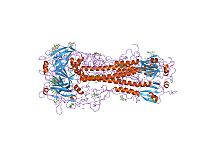
Photo from wikipedia
Seasonal influenza and the threat of global pandemics present a continuing threat to public health. However, conventional inactivated influenza vaccines (IAVs) provide little cross-protective immunity and suboptimal efficacy, even against… Click to show full abstract
Seasonal influenza and the threat of global pandemics present a continuing threat to public health. However, conventional inactivated influenza vaccines (IAVs) provide little cross-protective immunity and suboptimal efficacy, even against well-matched strains. Furthermore, the protection against matched strains has been shown to be of a short duration in both mouse models and humans. M2SR (M2-deficient single-replication influenza virus) is a single-replication vaccine that has been shown to provide effective cross-protection against heterosubtypic influenza viruses in both mouse and ferret models. In the present study, we investigated the duration and mechanism of heterosubtypic protection induced by M2SR in a mouse model. We previously showed that M2SR generated from influenza A/Puerto Rico/8/34 (H1N1) significantly protected C57BL/6 mice against lethal challenge with both influenza A/Puerto Rico/8/34 (H1N1, homosubtypic) and influenza A/Aichi/2/1968 (H3N2, heterosubtypic), whereas the inactivated influenza vaccine provided no heterosubtypic protection. The homosubtypic protection induced by M2SR was robust and lasted for greater than 1 year, whereas that provided by the inactivated vaccine lasted for less than 6 months. The heterosubtypic protection induced by M2SR was of a somewhat shorter duration than the homosubtypic protection, with protection being evident 9 months after vaccination. However, heterosubtypic protection was not observed at 14 months post vaccination. M2SR has been shown to induce strong systemic and mucosal antibody and T cell responses. We investigated the relative importance of these immune mechanisms in heterosubtypic protection, using mice that were deficient in B cells or mice that were depleted of T cells immediately before challenge. Somewhat surprisingly, the heterosubtypic protection was completely dependent on B cells in this model, whereas the depletion of T cells had no significant effect on survival after a lethal heterosubtypic challenge. While antibody-dependent cellular cytotoxicity (ADCC) has been demonstrated to be important in the response to some influenza vaccines, a lack of Fc receptors did not affect the survival of M2SR-vaccinated mice following a lethal challenge. We examined the influenza proteins targeted by the heterosubtypic antibody response. Shortly after the H1N1 M2SR vaccination, high titers of cross-reactive antibodies to heterosubtypic H3N2 nucleoprotein (NP) and lower titers to the stalk region of the hemagglutinin (HA2) and neuraminidase (NA) proteins were observed. The high antibody titers to heterosubtypic NP persisted one year after vaccination, whereas the antibody titers to the heterosubtypic HA2 and NA proteins were very low, or below the limit of detection, at this time. These results show that the intranasal M2SR vaccine elicits durable protective immune responses against homotypic and heterosubtypic influenza infection not seen with intramuscular inactivated vaccines. Both the homo- and heterosubtypic protection induced by the single-replication vaccine are dependent on B cells in this model. While the homosubtypic protection is mediated by antibodies to the head region of HA, our data suggest that the heterosubtypic protection for M2SR is due to cross-reactive antibodies elicited against the NP, HA2, and NA antigens that are not targeted by current seasonal influenza vaccines.
Journal Title: Vaccines
Year Published: 2022
Link to full text (if available)
Share on Social Media: Sign Up to like & get
recommendations!